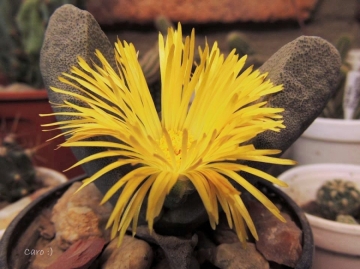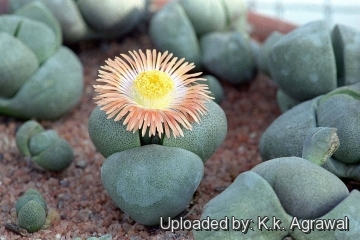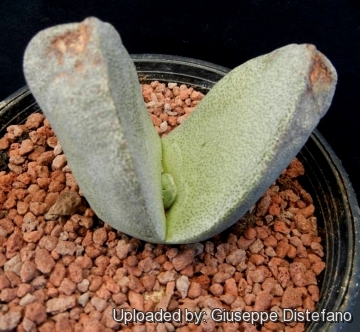Accepted Scientific Name: Pleiospilos bolusii (Hook.f.) N.E.Br.
Gard. Chron. ser. 3 80: 89 1926

Mesembryanthemum bolusii (Pleiospilos bolusii) Photo by: Giuseppe Distefano
Origin and Habitat: Sundays River valley (Graaff-Reinet and Aberdeen) in the Eastern Cape karoo, Eastern Cape and Western Cape of South Africa.
Altitude: Pleiospilos bolusiiSN|26555]]SN|26555]] grows at an altitude of 750–1100 metres above sea level.
Synonyms:
See all synonyms of Pleiospilos bolusii
back
Accepted name in llifle Database:Pleiospilos bolusii (Hook.f.) N.E.Br.Gard. Chron. ser. 3 80: 89 1926Synonymy: 4
back
Common Names include:
ENGLISH: Mimicry plant, Living stones, Living rock
AFRIKAANS (Afrikaans): Kwaggabal
Description: Pleiospilos bolusiiSN|14724]]SN|26555]] is a small unbranched or only slightly branched, stemless perennial succulent growing to 8 cm tall by 15 cm wide. It produces showy daisy-like yellow flowers that are large in relation to the overall size of the plan. The vegetative body is reduced to two or four rock-like leaves that closely resemble pieces of granite, practically indistinguishable from the surrounding pebbles, serving both as a water-conserving adaptation and as a protective camouflage against animal predation.
Leaves: Two or four, opposite, dull green to grey-green in colour, rough, quite thick, fused at the base, almost triangular with a flat upper surface. Margins entire. The leaves are longer and more angular than those of the closely related Pleiospilos neliiSN|26555]]SN|14724]], but in both cases the shape and texture of the leaves resemble a pile of split pebbles. The surface is speckled with small dark dots or micro-windows (idioblasts) that allows the light to penetrate deep into the assimilatory tissue.
Flowers: 1-3 produced between the two large succulent leaves, 6–8 cm in diameter, yellow, many-petaled often coconut-scented.
Blooming season: The flowering period extends from August to September.
Bibliography: Major references and further lectures:
1) AFPD. “African Flowering Plants Database - Base de Donnees des Plantes a Fleurs D'Afrique”. [http://www.sanbi.org] © 2012 Conservatoire et Jardin botaniques & South African National Biodiversity Institute
2) Gibbs Russell, G. E., W. G. Welman, E. Reitief, K. L. Immelman, G. Germishuizen, B. J. Pienaar, M. v. Wyk & A. Nicholas. “List of species of southern African plants.” in Mem. Bot. Surv. S. Africa 2(1–2): 1–152(pt. 1), 1–270(pt. 2). 1987.
3) Heidrun E. K. Hartmann “Aizoaceae F – Z” Springer, 2002
4) James Cullen, Sabina G. Knees, H. Suzanne Cubey “The European Garden Flora Flowering Plants: A Manual for the Identification of Plants Cultivated in Europe, Both Out-of-Doors and Under Glass - Casuarinaceae to Aristolochiaceae” Cambridge University Press, 11/ago/2011
5) Jacobsen. “Handbook of succulent plants” 1328 (1960)
6) RHS “A-Z encyclopedia of garden plants.” United Kingdom: Dorling Kindersley. 2008
7) Doreen Court “Succulent Flora of Southern Africa” CRC Press, 01/giu/2000
8) Pleiospilos bolusii in: Bot. Jahrb. Syst. 106: 474 1986
9) Thomas Scott “ABC Biologie” Walter de Gruyter, 1996
10) “Life Strategies of Succulents in Deserts: With Special Reference to the Namib Desert” CUP Archive, 1992
 Mesembryanthemum bolusii (Pleiospilos bolusii) Photo by: Carolina González
Mesembryanthemum bolusii (Pleiospilos bolusii) Photo by: Carolina González Mesembryanthemum bolusii (Pleiospilos bolusii) Photo by: K.k. Agrawal
Mesembryanthemum bolusii (Pleiospilos bolusii) Photo by: K.k. Agrawal Mesembryanthemum bolusii (Pleiospilos bolusii) Photo by: Giuseppe Distefano
Mesembryanthemum bolusii (Pleiospilos bolusii) Photo by: Giuseppe Distefano Mesembryanthemum bolusii (Pleiospilos bolusii) Photo by: K.k. Agrawal
Mesembryanthemum bolusii (Pleiospilos bolusii) Photo by: K.k. AgrawalCultivation and Propagation: It is a very adaptable plant, it will grow whenever it has water and good sunlight, but it will become dormant in very hot weather to conserve water. It need full sun to light shade with a very open compost that drains quickly. The container should be at least 10 cm deep to accommodate the long tap root. Very little water is needed during the growing season, and we do not fertilize the plants. In late summer to early fall before nighttime temperatures fall, watering of the plants is stepped up to once a week. When the nighttime temperatures drop to 9°C, watering is restricted throughout the winter months. In the winter, it grows new leaves from the centre of the split, and the new leaves then consume the old leaves. If the plant is over watered, the old leaves remain and the plant usually rots and dies. Not to water it when it is splitting, just leave it alone. Even with no watering the leaves don't shrink and prune up like some succulents do when they are not watered they stays plump even after several months with no water. For an idea of how succulent these plants are, a mature specimen can easily go a whole year without any water in a typical European or North American climate. If the plants are grown correctly, ideally there should only ever be 2 pairs of leaves. The lower ones are the previous years, and the top ones, the current years. One sign of good care is a firm, round, symmetrical plant with no old leaves still attached at the end of summer. The plants are hardy down to -5°C.
Propagation: Seeds or by division in early spring before new growth starts. One should not divide clumps too often because they bloom best when crowded.














